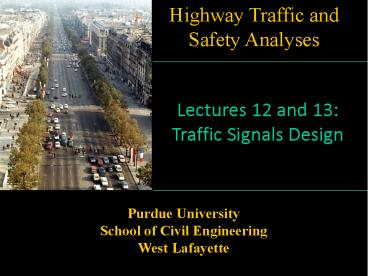Lectures 12 and 13: Traffic Signals Design - PowerPoint PPT Presentation
Title:
Lectures 12 and 13: Traffic Signals Design
Description:
Extending green time for a new vehicle ... Maximum Green Times. Vehicle Extension Times. Density Functions. Stop-bar ... http://www.dot.state.mn.us ... – PowerPoint PPT presentation
Number of Views:2173
Avg rating:3.0/5.0
Title: Lectures 12 and 13: Traffic Signals Design
1
Highway Traffic and Safety Analyses
Lectures 12 and 13 Traffic Signals Design
Purdue University School of Civil
Engineering West Lafayette
2
Signal Phases
3
Signal Phases
2
3
4
8
7
6
5
4
Signal Actuation
- Primary operations of signal actuation
- Extending green time for a new vehicle
approaching the intersection - Skipping signal phases if no call during the red
signal - Important settings
- Gap (fixed or adjustable)
- Unit extension (also called vehicle extension)
- Minimum green (fixed or adjustable)
- Maximum green (or maximum extension)
5
Detectors for Signal Actuation
Phases and overlap
6
Signal Coordination
3
4
1
2
8
7
5
6
Same cycle
7
Signal Coordination
8
Signal Design Process
Phases (Ring Structure)
Detectors
Timing
Coordination
Minimum Green Times
Video and Inductive Loop Detectors
Signal Cycle
Change Periods
Phase Splits (Force-off Points)
Pulse and Presence Detectors
Pedestrian Signals
Offsets
Stop-bar and Advance Detectors
Maximum Green Times
Time-of-day (TOD) Plans
Vehicle Extension Times
Vehicle and Bike Detectors
Density Functions
9
Ring Structure
Navigation
10
Ring Structure
Navigation
11
Minimum Green Times
Absolute minimums 5 s for left turns
10 s main street through movements 7 s
side street through movements Adjustments for
unusual traffic volumes are recommended
Navigation
12
Change Periods
tr 1.0 s a 10 ft/s2 W intersection width
(ft) L vehicle length (ft) V speed (m/h)
Navigation
13
Pedestrian Signals
Minimum walk time 7 s Pedestrians change period
W/Vp Vp 4 ft/s in typical situation Walk
time Pedestrian change period must not be
longer than the Vehicle maximum green Vehicle
change period
Navigation
14
Maximum Green TimesFree Operation
Maximum green time 1.5 x Green time obtained
for X 0.95 Guidance when optimal splits are
not known Main street maximum green 75
seconds Side street maximum green 60
seconds Left-turn maximum green 50 seconds
Maximum green must not be excessively long to
avoid discomfort among drivers
Navigation
15
Maximum Green TimesCoordination
Maximum green time 1.3 x Green time obtained
from optimization software (Synchro, Transyt, or
Passer) Guidance when optimal splits are not
known (coordination) Main street maximum green
50 seconds Side street maximum green 40
seconds Left-turn maximum green 35 seconds
Navigation
16
Vehicle Extension TimesStop-bar Detectors
Vehicle extension (s) 3 (LD)/(1.47V) L
vehicle length (ft) D detection zone length
(ft) V speed (m/h)
Navigation
17
Vehicle Extension TimesAdvance Detectors
Vehicle extension (s) DS/(1.47V) DS
detection setback (ft) V speed (m/h)
Navigation
18
Density FunctionsMinimum Green Extension for
Advance Detectors
Maximum initial green from table below
Second/actuation Maximum initial green/Storage
in all lanes
Navigation
19
Density FunctionsVariable Gap
Minimum gap 3 seconds Maximum gap Min
(Vehicle extension, 5 seconds) Time before
reduction 33 of maximum green Time to
reduction 80 of maximum green
Gap
Vehicle extension or 5 s
3 s
Time before reduction
Green elapsed
Time to reduction
Navigation
20
Video and Inductive Loop Detectors
- 1. Inductive loop detectors detect standing
vehicles as well as moving ones. The detection
area is roughly that enclosed by the loop. - 2. Video detectors have similar capabilities as
the inductive loop detectors. They require video
cameras installed at the intersection. - The longitudinal location (setback) of
detectors relative to the stop line depends on
the speed of traffic and the type of detector
operation desired.
Navigation
21
Pulse and Presence Detectors
Navigation
22
Stop-bar and Advance Detectors
Navigation
23
Vehicle and Bike Detectors
Navigation
24
Signal Cycle
Obtained from optimization software or calculated
for the busiest intersection (X 0.95)
Navigation
25
Phase Splits (Force-off Points)
Navigation
Force-off points (F.O.) are obtained from
optimization software or from calculations of the
average green times for semi-actuated controllers.
26
Offsets
Navigation
System zero
Offsets are obtained from optimization software
or from a time-space diagram.
27
Time-of-day Plans
- Coordination plans (cycle, splits, and offsets)
for different time periods - Table of plan-to-plan switch times
- Free mode possible if justified (night?)
Navigation
28
Sources
- A. Nichols, Design Guidelines for Deploying
Closed Loop Systems, MS Thesis, Purdue
University, December 2001. - Minnesota DOT site with useful course materials
on signals design (on-line) - http//www.dot.state.mn.us/metro/trafficeng/dsg_cr
se/ - Minnesota DOT Traffic Engineering Manual, Chapter
9, Traffic Signals - http//www.dot.state.mn.us/trafficeng/otepubl/tem/































